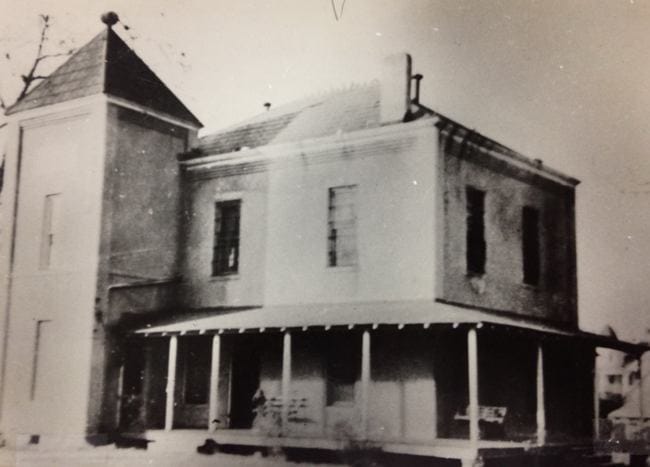

Uh oh...
It appears that you're using a severely outdated version of Safari on Windows. Many features won't work correctly, and functionality can't be guaranteed. Please try viewing this website in Edge, Mozilla, Chrome, or another modern browser. Sorry for any inconvenience this may have caused!
Read More about this safari issue.

I am often fascinated by the small stories and happenings of a community. History can sometimes seem like a jumble of big events. Maybe it comes from the years I spent helping with genealogical research at the public library, but I love to comb through the salvaged artifacts and notations in store ledgers and land records looking for the history of an area. Here in Conway, The Faulkner County Museum is the key to unlocking those histories.
Old buildings can live many lives if the years are kind and they stay standing long enough. The brick red stucco building at 801 Locust Street in Conway, Arkansas served many purposes and survived the years as a jail, library and now, a museum. If buildings could talk I am sure it would have some tales to tell. And due to the diligent efforts of The Faulkner County Museum Director Lynita Langley-Ware and a host of volunteers, those tales are not lost.

Built in 1896 as the county jail, it cost approximately $2500. The 30×30 building with two foot thick walls had a bottom level that served as the jailer’s family living quarters, with the jail cells located on the second level. The jailer was paid $25 a month and the jailer’s wife cooked all the meals for the inmates. There was no record that the jailer’s wife was compensated for her culinary efforts.

In 1937 the Faulkner County Courthouse opened its doors with a new jail located on the 4th floor. As part of the New Deal program, The Works Progress Administration (WPA later renamed the Work Projects Administration) transformed the former jail into the Faulkner County Public Library. The cells and porches were removed, interior walls relocated and shelves constructed inside. Now the building held books instead of the county criminals. For 57 years the building served as the library until 1995 when a new facility was built.
So what to do with a building that had dedicated so much of its existence to the people of Faulkner County? Some wanted it to become office space, but that would have truly been a sad ending to the life of this building in my opinion. So along came the Faulkner County Museum. Founded August 19, 1992 through the efforts of Dr. George Thompson, “The mission of the Faulkner County Museum is to educate the public about the history and prehistory of the geographical region that became Faulkner County.” In 1995 the founders of the museum started crafting exhibits from artifacts and stories they had collected over the past years. It took two years but the Faulkner County Museum finally opened to the public in 1997.

In chronicling the history of Faulkner County, the museum has extensive exhibits on the importance of the railroads to this area. The complete upper level which once housed the thieves, drunkards and arsonist (I had a good look at the old jailer’s log!) of the county is now home to a model train display of Conway during the 1940s and other mementos and memorabilia of the railroads. This is still a favorite of my family.


Not only does the museum building and the collections and exhibits inside offer engaging histories and stories, but there are other attractions on the property outside. You can’t miss the 1850s Dogtrot Cabin as you pull into the parking lot. Relocated next to the museum property in 1969 from a field east of Conway, it is one of the oldest and best preserved log structures from Faulkner County’s history. It is one of the more popular exhibits of the museum frequently used for open houses, school group tours, and even a couple of documentary films. The Dogtrot Cabin is also a popular backdrop for weddings.

Behind the Dogtrot Cabin you will find an old sorghum shed and heirloom garden which is representational of the agricultural heritage of the area. The gardens of the museum are maintained by the Faulkner County Master Gardeners and used as an extended learning environment. Each plant is chosen on its culinary, ornamental, medicinal, or economic contribution to the residence of the county. Many of the outdoor exhibits have been established due to Eagle Scout projects. You will also find a time capsule that was put together by a local Girl Scout troop in 1973. Be sure to stop by in another 56 years for its centennial reopening.
Today the historic building that houses The Faulkner County Museum is 121 years old and getting a much needed facelift. Last year just as they were getting the remodeling ball rolling, the museum closed because of a mold outbreak. They sealed the building and installed a new roof to keep out the water. They were $110,000 in before they had even started. But the remodeling promises for a much improved museum experience. A new research and library area will make surname and family history research more accessible. There will be new map storage, a conference room and volunteer workspace. A new lobby area will welcome guests along with a gift shop that highlights authors, artists, and artisans with a connection to Faulkner County. The exhibition area will be reconfigured to operate on a rotating schedule so that people can see different items more often. They will also upgrade other facilities to be more ADA compliant and energy efficient.
How can you help? Faulkner County residence can select to pay the voluntary millage when they pay their property taxes. The small donations from the voluntary millage add up and help keep the lights on and the model trains running. Currently they are seeking corporate sponsors and private donors. They are also selling engraved bricks for $100 apiece to go in the sidewalk and 25 year commemorative Christmas ornaments.


Lynita and her team of volunteers work hard to keep the histories and stories of the people connected to their place here in Faulkner County. “That’s part of why I love this job. There are days when I am trying to write grants, make bank deposits, do what the board needs me to do, or I am dealing with building contractors when somebody comes in and they want to tell me about great grandma that came over here on a wagon.” So even though Lynita has a stack of admin duties to get to, she sets it aside and says, “Let’s talk about it anyway!”
So if you love the small stories that build a big history or are fascinated by trains, you will want to make a stop at the Faulkner County Museum in Conway.
Join the Conversation
Leave a Comment
One response to “Unlocking History at the Faulkner County Museum”
 Leave a Reply
Leave a Reply
We do the work.
You check your email.
Sign up for our weekly e-news.
Get stories sent straight to your inbox!












 Leave a Reply
Leave a Reply
[…] pools. The state was also the beneficiary of a multitude of other New Deal projects, including the Faulkner County Museum, the Dyess Colony and the many projects completed by the Civilian Conservation […]